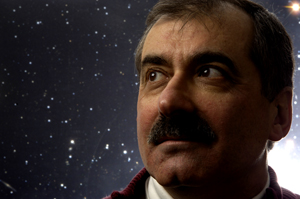|
||
      |
Dancing with the stars
A public audience gets a chance to grill four top cosmologists on the big bang, extra dimensions, and dark energy.

“Looking out in space is looking back in time,” notes U of
C cosmologist Rocky Kolb.
It didn’t take long for moderator Ira Flatow, host of National Public Radio’s Talk of the Nation: Science Friday program, to set aside his prepared questions for the four scientists on the Millennium Park Harris Theater stage. Audience members—who almost filled the 1,525 seats at the free public panel sponsored by the University’s Department of Astronomy and Astrophysics, the Kavli Institute for Cosmological Physics, the Adler Planetarium and Astronomy Museum, and the Illinois Humanities Council—had lined up six and seven deep at two microphones with their own queries.
These folks had done their homework. “Are dark matter and antimatter the same thing?” one questioner, a 20-something guy in a flannel shirt, began. “And does the existence of dark matter put in question the big bang theory?” In fact, answered Harvard physicist Lisa Randall, dark matter and antimatter are different concepts. While antimatter can “annihilate matter,” dark matter is “dark” because it doesn’t interact electromagnetical-ly, or with photons. It does, however, interact with gravity. As for the big bang, offered Case Western physicist Lawrence Krauss, dark matter actually strengthens the theory, helping cosmologists understand how the universe formed.
Flatow, at this point still holding his notes, wanted to move on to the hot topic of extra dimensions, but a corner of the crowd shouted that there was another audience question. The moderator could be forgiven for overlooking the asker, an elementary schooler who couldn’t reach the microphone without his father releasing it from its stand. “Is matter energy?” the boy asked. “And that tiny spark that started the big bang—how were matter and energy formed?” Chicago cosmologist Rocky Kolb joked to the youngster: “We’re hiring graduate students.” To answer his first question, Randall offered, “Matter is a form of energy—in a sense.” Responding to his other question, she said, “We wish we knew that, but we don’t.”
Flatow pressed the experts: “And what came before the big bang?” Stephen Hawking, noted Krauss, would argue that such a query “isn’t a good question.” If time arose only after the big bang, then what came before it doesn’t matter. Randall added, “It’s somewhat analogous to asking, What’s north of the north pole?”
Then Flatow finally got to ask the panelists about extra dimensions. Randall, author of Warped Passages: Unraveling The Mysteries Of The Universe’s Hidden Dimensions (2005), predicted that scientists would conduct experiments to detect extra dimensions within five years. They also discussed dark energy, the mys--terious substance recently discovered to make up 70 percent of the universe. Noting that dark energy was found inadvertently, while scientists were studying supernovae, Carnegie Observatories director Wendy Freedman, the lone experimentalist among the group of theorists, said, “All of these things came from measurements that weren’t predicted.”
Returning to the big bang, an older man asked: “With the Hubble Space telescope, you’re seeing galaxies approximately 12 billion light-years’ distance in any one direction. If you could see farther, would you be seeing the curvature back to the big bang itself?”
Freedman took this one: “What we can see as observers is defined by the speed at which light can travel and the age of the universe. We can’t see objects that are more distant than that.” But with microwave detectors astronomers can look back to about 400,000 years after the big bang. “The challenge right now,” Freedman said, “is to try to learn something about the period between 400,000 years and about a billion years after the big bang,” when galaxies, stars, “and maybe even the first black holes” were formed. “There’s a period in that interval which we refer to as the dark ages, which we know absolutely nothing about.” By about 2012, she said, NASA plans to have Hubble’s successor, the James Webb Space Telescope, in place, and one of its first goals is to measure “the first light in the universe.”
Then Kolb took a stab at the question. “You’re absolutely correct that looking out in space is looking back in time,” he said. “If we look out in space back in time to when the universe was 400,000 years old, it becomes so hot and dense that it’s opaque and we can’t see through it. So no matter how large of an optical telescope, or any other telescope that uses electromagnetic radiation of any wavelength, we would never be able to look out in space back in time earlier than 400,000 years after the big bang.” Yet both neutrinos and gravity, he explained, “interact much more weakly than protons” and will “go through the universe even when it’s opaque and light will not go through it.” So by identifying, for instance, gravitational waves from the early universe-—detectors for which scientists are currently at work—“we could potentially look out in space back in time to a very tiny fraction of a second after the bang.”
The crowd asked more questions, including whether objects would have moved faster than the speed of light for a “big crunch” to occur, how tiny a dimension has to be before it ceases to be a dimension, and how a black hole can radiate. After two hours Flatow called the session to a halt. Recalling Randall’s prediction that in five years scientists will have begun extra-dimension experiments, he suggested the whole group return to Millennium Park in 2011—questions, perhaps, answered.